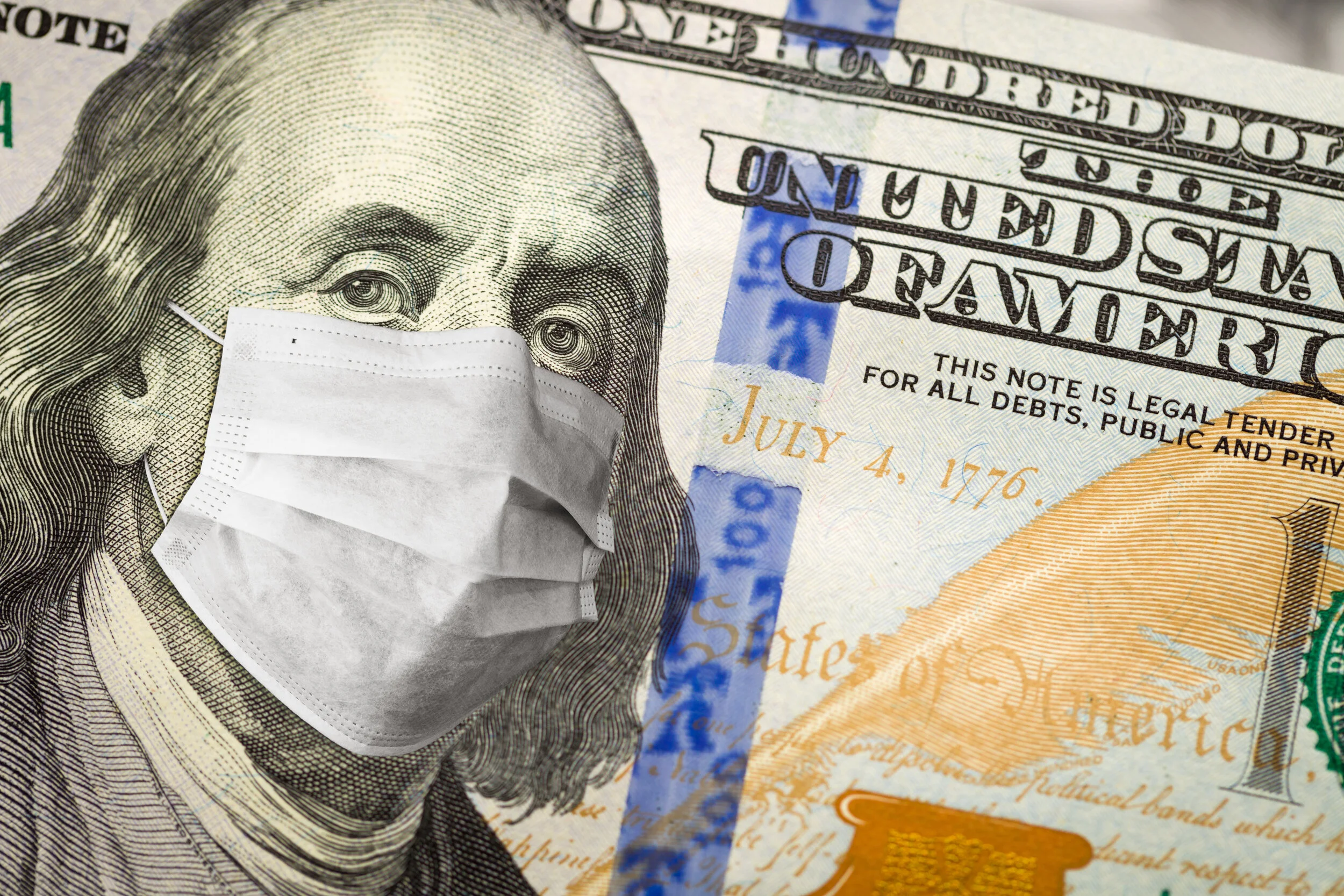We use PWBM’s new dynamic model enhancement of the business sector to analyze several foreign and domestic business taxation provisions from the Biden tax plan. While raising the effective tax rate on foreign profits increases domestic capital, wages, and GDP, provisions that raise domestic business taxes have the opposite effect—when combined, these business tax provisions decrease the capital stock by 0.21 percent and decrease wages by 0.69 percent in 2050.
The Long-Run Fiscal and Economic Effects of the CARES Act
PWBM estimates that the CARES Act increases GDP by about 5 percent in 2020 while lowering GDP by 0.2 percent in 2030.
Coronavirus Policy Response Simulator: Health and Economic Effects of State Reopenings
Using an integrated, interdisciplinary modeling approach, this simulator forecasts the state-level health and economic effects of reopening businesses and relaxing stay-at-home orders. This simulator will be updated regularly as new data arrive.
Short-Term Economic Effects of a “Phase 4” Infrastructure Response to Coronavirus
We estimate that a large infrastructure bill would increase GDP by no more than $360 billion per year for 2020 and 2021. Short-run GDP expansion from new infrastructure spending is limited by available projects and likely social distancing measures, and so states could not absorb more than $300 billion per year in new federal aid over the next two years.
Short-Run Economic Effects of the CARES Act
Without the CARES Act, PWBM projects that U.S. GDP would have fallen at an annualized rate of 37 percent in 2020 Q2, with the unemployment rate reaching 12 percent by 2020 Q3.
PWBM estimates that the CARES Act will dampen the short-term decline in GDP to a 30 percent annualized rate in 2020 Q2, with the unemployment rate reaching 11 percent by 2020 Q3.
We project that the CARES Act will produce around 1.5 million additional jobs by 2020 Q3 and increase GDP by $812 billion over the next two years.
Lasting Macroeconomic Impacts of the Coronavirus Crisis, Absent Fiscal Policy Response
We estimate the lasting macroeconomic effects of the anticipated recession due to coronavirus, as the initial shock leads to lower federal revenue and higher debt. If the economy recovers the year after a deep recession ("V shape"), we project that federal debt will be 3.2 percent higher and GDP will be 0.3 percent lower by 2030. If the recovery occurs over two additional years (“U shape”), federal debt rises by 5.9 percent and GDP falls by 0.6 percent lower by 2030. Barring future fiscal policy to reduce debt, so-called “potential GDP” will, therefore, be permanently lower due to the coronavirus.
Recession Simulator
This simulation tool uses the experience of the Great Recession of 2007-2009 as a template to simulate key economic indicators during a recession beginning in March, 2020.
President Trump’s Payroll Tax Holiday: Budgetary, Distributional, and Economic Effects
In response to the economic effects of the coronavirus, President Trump has proposed a payroll tax holiday that would temporarily eliminate all Social Security and Medicare payroll taxes through December 31st, 2020. PWBM projects that this payroll tax holiday would cost $807 billion if the holiday were run from April 1 through December 31, 2020.
Households in the bottom 20 percent of the income distribution—those households with the highest willingness to spend their tax savings—would receive about 2 percent of the total tax cut and only a third of these households would see any tax savings due to low levels of taxable income. Tax savings would also accumulate slowly over time relative to direct government spending.
PWBM estimates that eliminating payroll taxes would have little net impact on the economy in the short run and would reduce the size of the economy by 0.1 percent in 2030 and 0.2 percent in 2050 due to additional debt.
The Updated Biden Tax Plan: Budgetary, Distributional, and Economic Effects
Presidential candidate Joe Biden’s updated tax plan includes a “donut hole” payroll tax and repeals major provisions in the Tax Cuts and Jobs Act for higher-income tax filers.
Relative to current law, PWBM projects that the updated Biden tax plan would raise between $3.1 trillion (including macroeconomic effects) and $3.7 trillion (not including macroeconomic effects) over fiscal years 2021-2030 while decreasing GDP by 0.6 percent in 2030 and 0.7 percent in 2050.
We project that 54 percent of the updated Biden tax plan falls on the top 0.1 percent of the income distribution, corresponding to an average tax increase of more than $1.3 million per taxpayer and an 18 percent reduction in their after-tax income. The top 1 percent of the income distribution pays about 80 percent of the tax change.
Analysis of the Sanders Plan for Social Security
Democratic presidential candidate Senator Bernie Sanders has proposed changes to Social Security policy that increase benefits for low earners and increase program income by levying “donut hole” payroll taxes on those with earnings above $250,000 and by dedicating proceeds from a new tax on high investment income to the program.
The plan would reduce the conventionally-measured long-range imbalance by 2.3 percent of taxable payroll, leaving an imbalance of 1.2 percent of taxable payroll.
The plan would decrease GDP by 0.9 percent in 2030 and 1.0 percent in 2050 as a result of reduced capital formation due to the increased tax on investment as well as the new type of payroll tax (the “donut hole” tax) which distorts labor supply by more than the standard payroll tax.
Analysis of the Biden Plan for Social Security
Democratic presidential candidate Joe Biden has proposed changes to Social Security policy that would increase benefits, especially for low earners, while raising more revenues from high-earning individuals.
The plan would reduce the conventionally-measured long-range imbalance by 1.5 percent of taxable payroll, leaving an imbalance of 2.0 percent of taxable payroll.
The plan would decrease GDP by 0.6 percent in 2030 and 0.8 percent in 2050 due to a reduction in capital formation as well as a new type of payroll tax (the “donut hole” tax) that distorts labor supply by more than the standard payroll tax.
Comparing Progressive Tax Proposals
PWBM’s new interactive tax policy tool allows users to explore different ways of raising taxes on high-income households—a common theme in the policy platforms of several of the 2020 presidential candidates. Users can build their own tax and spending plan from among 18 specific policy options—with 575 possible combinations—to see the total budgetary and economic consequences of their selected policies.
Video: PWBM's Stylized Medicare For All Model
Diane Lim, Director of Outreach and Senior Advisor at PWBM, and Felix Reichling, PWBM Senior Economist, discuss our new integrated health, budget, and economic model and a stylized analysis of universal Medicare.
Senator Sanders’ Medicare for All (S.1129): An Integrated Analysis
Under current law, we recently projected that the percent of the population without medical insurance will more than double over the next 40 years, growing from around 10 percent today to over 27 percent by 2060. Under Sanders’ Medicare for All, the uninsured rate would essentially fall to zero by design.
We project that the Sanders’ Medicare for All would improve population health by 2060, reduce the share of the population that is seriously ill from 15 percent to 13 percent, increase life expectancy by 2 years, grow the population 3 percent, and increase worker productivity.
Taken literally, Sanders’ plan lacks a financing mechanism, which by long-standing CBO and PWBM convention implies deficit financing. Under deficit financing, we project that the Medicare for All Act would reduce GDP by 24 percent by 2060, despite large efficiency gains from lower overhead and reimbursement costs.
As a presidential candidate, Senator Sanders, however, has stated his intent to also increase taxes, although he has not specified the actual tax changes tied to Medicare for All. Accordingly, we also analyze two alternative financing mechanisms that mostly finance benefits received by workers. With premium financing, where most workers pay the same insurance premium (subsidized for lower-income workers)—similar to private insurance with no risk adjustments—we project that GDP increases slightly by 0.2 percent by 2060. With payroll tax financing, where workers with higher wages pay more, GDP falls by 15 percent.
We also provide various robustness checks to key model assumptions and plan design. For example, without the expansion of plan benefits to include long-term care or dental, but still including the elimination of most deductibles while covering all workers, GDP increases by 12 percent under premium financing. These results indicate that Medicare for All could be designed in a way that boosts economic growth.
Medicare for All: Comparison of Financing Options
We analyze a stylized mandatory single payer system (“Medicare for All” or “M4A”) system that provides the same benefits currently available under Medicare to the working-age population. This brief lays the foundation for future analysis of plans that expand Medicare benefits and coverage while also seeking additional cost savings.
We project that under current law, the percent of the population without medical insurance will more than double over the next 40 years, growing from around 10 percent today to over 27 percent by 2060.
We project that a shift to a mandatory single-payer system (Medicare for All) increases life expectancy by almost 2 years, grows the population size by 3 percent, and increases worker productivity through improved health, before macroeconomic feedback effects.
The choice of funding mechanism, however, is critical for macroeconomic performance. We project that financing M4A with a premium that is independent of a worker’s labor income would increase GDP by about 16 percent by 2060 through a combination of cost savings and productivity increases. In contrast, financing M4A with a new payroll tax that is proportional to a worker’s labor income would reduce GDP by roughly 3 percent, whereas deficit financing would reduce GDP by almost 15 percent by 2060.
Senator Bernie Sanders' Wealth Tax: Budgetary and Economic Effects
Senator Bernie Sanders has proposed a graduated wealth tax starting at 1 percent of net worth above $32 million and climbing to 8 percent on net worth above $10 billion, which his presidential campaign has reported as raising $4.35 trillion over 10 years.
PWBM estimates that the proposal would raise about $3.3 trillion over fiscal years 2021-2030, not including macroeconomic effects. Including macroeconomic effects, PWBM estimates that the proposal would raise about $2.8 trillion over the same period.
PWBM projects that the proposal would reduce GDP by 1.1 percent in 2050. Average hourly wages in the economy in 2050, including wages earned by households not directly subject to the wealth tax, would fall by 1.0 percent due to the reduction in private capital
The Biden Tax Plan: Budgetary, Distributional, and Economic Effects
Former Vice President Joe Biden has proposed a plan to raise taxes on high-income households, which the Biden presidential campaign estimates would raise $3.2 trillion over 10 years. PWBM projects that this plan would raise between $2.3 trillion (including macroeconomic effects) and $2.6 trillion (not including macroeconomic effects) over fiscal years 2021-2030.
We project that more than half of the tax change falls on the top 0.1 percent of the income distribution, corresponding to an average tax increase of more than $1 million per taxpayer and a 14 percent reduction in their after-tax income. For all groups outside of the top 5 percent, average after-tax income decreases by less than 1 percent.
PWBM projects that this plan would have little impact on the aggregate economy, decreasing GDP by 0.1 percent by 2030 and increasing GDP by 0.1 percent by 2050.
Policy Options: Raising the Social Security Taxable Maximum
We estimate the budgetary, economic and distributional effects of raising the Social Security taxable maximum to $300,000 starting on January 1st, 2021. We project that it would raise $1.2 trillion of additional revenue on a conventional basis over the 10-year budget window and lower GDP 1.7 percent by 2050. Families in the top 10 percent of the income distribution would bear 93 percent of the overall burden of this tax increase.
Senator Elizabeth Warren’s Wealth Tax: Budgetary and Economic Effects
Senator Elizabeth Warren has proposed a wealth tax equal to 2 percent of net worth above $50 million and 6 percent of net worth above $1 billion, which her campaign estimates would raise $3.75 trillion over 10 years.
PWBM estimates that the proposal would raise about $2.7 trillion over fiscal years 2021-2030, not including macroeconomic effects. Including macroeconomic effects, PWBM estimates that the proposal would raise about $2.3 trillion over the same period.
PWBM projects that the proposal would reduce GDP by 0.9 percent in 2050 under the standard budget scoring convention that additional revenues reduce the deficit. If the revenues were instead spent on public investments, PWBM projects GDP in 2050 would fall between 1.0 and 2.1 percent, depending on the productivity of the investment. Average hourly wages in the economy in 2050, including wages earned by households not directly subject to the wealth tax, would fall between 0.8 and 2.3 percent due to the reduction in private capital formation.
Video Interview on PWBM's Analysis of Senator Elizabeth Warren’s Wealth Tax
Diane Lim, Senior Advisor at PWBM, and Richard Prisinzano, PWBM's Director of Policy Analysis, discuss our analysis of Senator Elizabeth Warren's wealth tax proposal released December 12, 2019.
To read the full analysis, please visit: whr.tn/PWBM-Warren-Wealth-Tax.
Video directed and edited by Kody Carmody.










